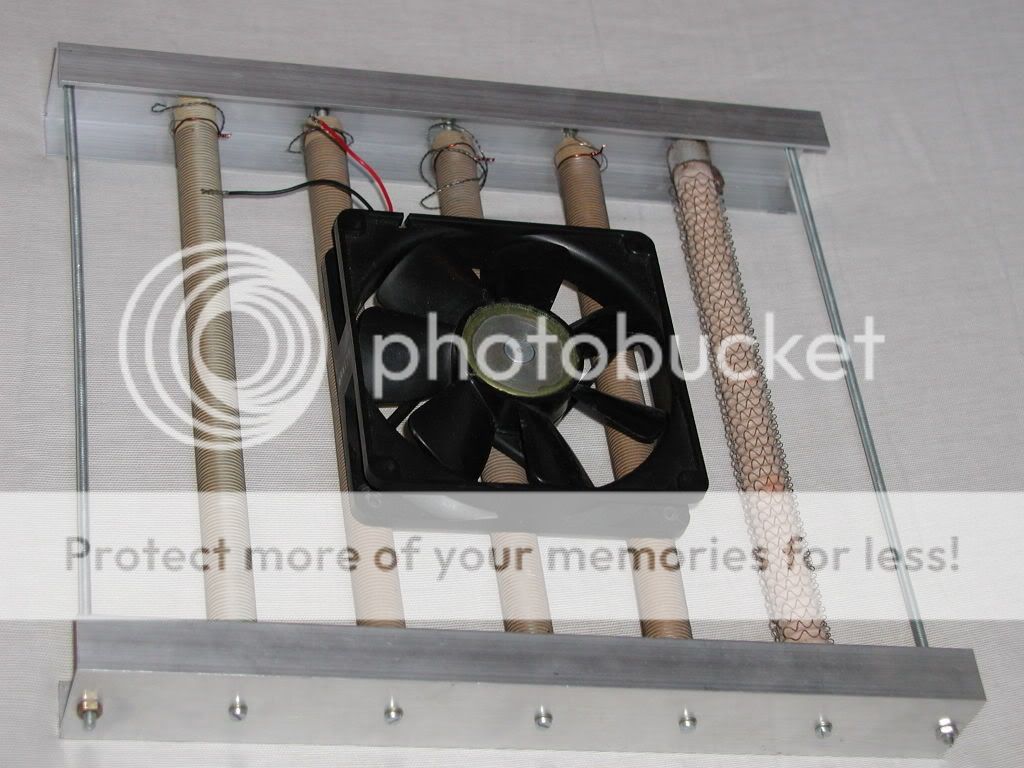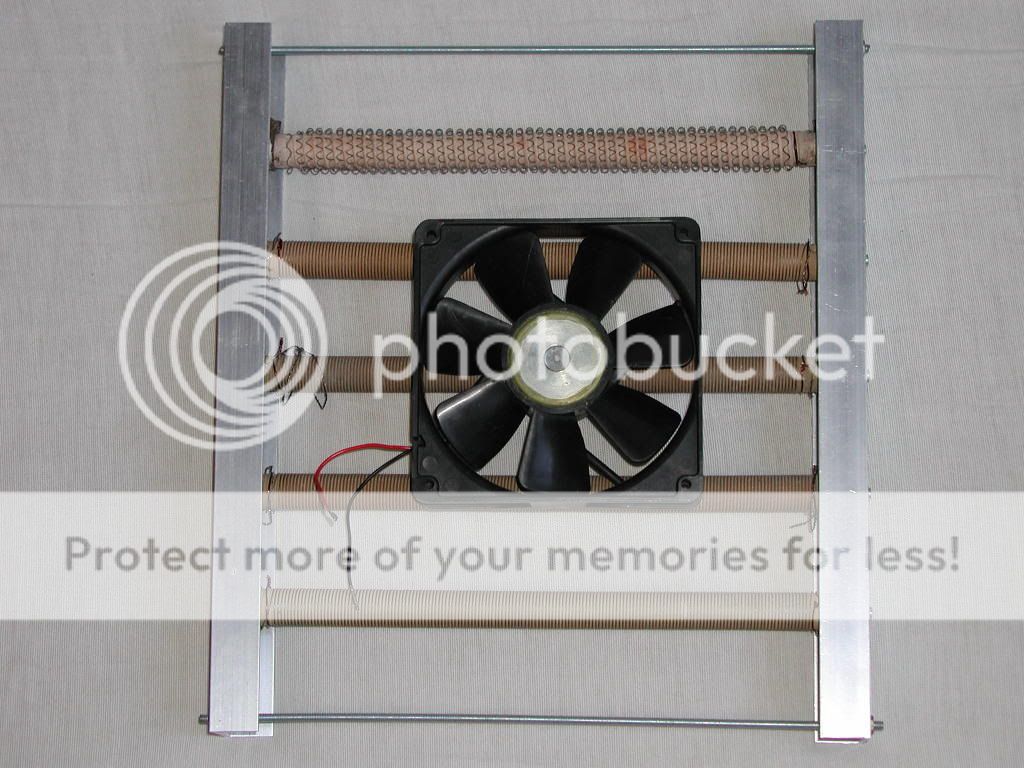Hi Luka!
First I am working with amplifiers over 30 years .This dummy load is not expensive for me , because i think very pro.I fired up 2 amps. into 4ohm, about 1h or more, never demaged any amp.This is good thing for cold winter nights
Red thing is PVC plate (insulator), & with jumpers I, manage 4, 8, 2ohm.
regards zeoN_Rider
First I am working with amplifiers over 30 years .This dummy load is not expensive for me , because i think very pro.I fired up 2 amps. into 4ohm, about 1h or more, never demaged any amp.This is good thing for cold winter nights
Red thing is PVC plate (insulator), & with jumpers I, manage 4, 8, 2ohm.
regards zeoN_Rider
Hi
This is what I have. It is 5x about 66ohme, 800w each power resistors that will be in wind tunnel, air pushed by 120mm/230Vac fan, one in pic is same size, but 12Vdc. I will be able to wire them any way I will need them to be. I need top and bottom plate one with hole for fan and connectors all on one side.


This is what I have. It is 5x about 66ohme, 800w each power resistors that will be in wind tunnel, air pushed by 120mm/230Vac fan, one in pic is same size, but 12Vdc. I will be able to wire them any way I will need them to be. I need top and bottom plate one with hole for fan and connectors all on one side.


X-rays were used to fit shoes once.
Asbestos was used in brake discs once.
Mercury was used to "cure" syphilis once.
... and Chlorine was used to kill enemy troops once.
Formaldehyde is still preserving the meat in the supermarkets.
Eat meat and live long
Gajanan Phadte
luka said:
Hi mzzj
I was thinking about resistors at first. But one 5w resistor costs 0.38€ here and you need a lot of them
OK, I get my resistors much cheaper from local surplus sales.
More likely something like 5euros/1000pcs.
Selection of resistance values is usually limited but there is always some sort of series/parallei combination that works for me.
If you are tight on budget look for toasters, washing machines, oven elements and so on whatever you can find in scrap piles.
Sauna stove elements are especially easy to find(at least here in Finland) 😀 and can take some serious loading.
altough a bit late,
I used 2 * 2 halogen light bulbs 12 v 50W in series setup to load-test power supplies for my class A amp. (which should deliver + and - 27 V @ a 3 A)
Fairly cheap and basically a . No need for a fan, only a pair of shades is needed
. No need for a fan, only a pair of shades is needed  .
.
Easy to extend to higher voltages and (by paralleling) to higher currents.
I used 2 * 2 halogen light bulbs 12 v 50W in series setup to load-test power supplies for my class A amp. (which should deliver + and - 27 V @ a 3 A)
Fairly cheap and basically a
 . No need for a fan, only a pair of shades is needed
. No need for a fan, only a pair of shades is needed  .
.Easy to extend to higher voltages and (by paralleling) to higher currents.
A note about using bulbs: The cold resistance of the filament is about 1/10 of the warm resistance of the filament. So, if you connect a cold bulb to the PSU, the bulb draws about 10 times more current, while it's not fully warm.
no.djQUAN said:I figured if the amp would survive bench testing on 3.7ohm loads then it will do 4ohm easy. besides, resistance goes up when they start heating up.
an amp rated to operate into a 4ohm speaker is much more highly stressed than a 2r0 test load.
Even 3r7 is not as severe as 8ohm reactive to 60degree phase angle.
I usually check the 10degree phase angle load at HALF the lowest value of operating speaker load.
i.e 4ohm 10degree and 8ohm 60 degree for an 8ohm capable amplifier.
The 4ohm test can then be run safely for the two or at most three seconds it takes to gather the test data before switching the input/output voltages back to -20db. And then letting it cool.
This allows setting up at 1% power levels and flick the switch to 0db to check output voltage or check scope display and switch back to -20db to make further adjustments. One can see clip developing as the smoothing caps discharge in half second or so.
Here's a "transistance" electronic load that's infinitely variable. It can be jazzed up with voltage and current meters, a cooling fan, etc.
http://www.qsl.net/vu2upx/images/psu6.jpg
http://www.qsl.net/vu2upx/images/psu6.jpg
Attachments
Hi draynes,
I don't think those electronic loads would appreciate an AC source like an amplifier. 😉
HP made some really nice loads, other brands as well. Nicely metered for voltage and current. DC loads only though!
-Chris
I don't think those electronic loads would appreciate an AC source like an amplifier. 😉
HP made some really nice loads, other brands as well. Nicely metered for voltage and current. DC loads only though!
-Chris
Okay, I thought the subject was power supply dummy loads. Duh.
Anyway, I built my own audio dummy load with a large number of 24 ohm 30 watt resistors I got from a surplus dealer. I series/paralleled dozens of them with a rotary switch to give me 4, 8, and 16 ohm loads for each channel, and added a bridge rectifier and scaling resistors for power meters on each channel. It's not pretty, but it works.
In an earlier life I used to work on 75-100 watt amps on an almost daily basis - electronic sirens - and got real workout replacing burned and melted parts. Curse the invention of the 30 amp fuse!
Anyway, I built my own audio dummy load with a large number of 24 ohm 30 watt resistors I got from a surplus dealer. I series/paralleled dozens of them with a rotary switch to give me 4, 8, and 16 ohm loads for each channel, and added a bridge rectifier and scaling resistors for power meters on each channel. It's not pretty, but it works.
In an earlier life I used to work on 75-100 watt amps on an almost daily basis - electronic sirens - and got real workout replacing burned and melted parts. Curse the invention of the 30 amp fuse!
Hi KSTR,
Yes, but it should be a non-issue for this thread.
Hi draynes,
Only your first two 2N3055's are connected correctly. The rest have a base to collector short, they are fancy forward based diodes. 😀
-Chris
Yes, but it should be a non-issue for this thread.
Hi draynes,
Only your first two 2N3055's are connected correctly. The rest have a base to collector short, they are fancy forward based diodes. 😀
-Chris
anatech said:.... they are fancy forward based diodes. 😀
-Chris
For a brief moment
😀
anatech said:Hi KSTR,
Yes, but it should be a non-issue for this thread.
Hi draynes,
Only your first two 2N3055's are connected correctly. The rest have a base to collector short, they are fancy forward based diodes. 😀
-Chris
Yeah, just noticed that myself after looking at it closely. I had gathered up the parts for this thing but had never got around to building it. Oh well, the concept is totally valid for DC testing.
At work I've used constant current electronic loads like this for battery testing. One project I got involved in some years back was manufacturing and testing thousands of battery backup supplies used in cell tower installations. The discharge testing phases were all done with transistance loads in order to maintain a constant discharge current.
I forget now which Asian company made the electronic loads we used, but they were essential for the job. Resistive loads would not have worked.
Hi draynes,

-Chris
Yes it is. Consider feeding a pulsed signal in, or rectified music to test regulated supplies. You could also feed in white noise. There is no way the draw needs to be constant, just a known quantity. Faster transistors may work better in that case. You could even simulate a loud transistor radio and 9 V battery.Oh well, the concept is totally valid for DC testing.

This also eliminates errors due to connection resistance that come into play with resistors.The discharge testing phases were all done with transistance loads in order to maintain a constant discharge current.
-Chris
Active loads with programmable IV characteristics are a standard part of ATE (Automatic Test equipment).
Electronic load please help
Help to find the schema for this load, broke down and there is no scheme please
http://www.pewa.de/DATENBLATT/DBL_BEHA_EL50_EL100_DATENBLATT_DEUTSCH.PDF
 😱 😕
😱 😕
Help to find the schema for this load, broke down and there is no scheme please
http://www.pewa.de/DATENBLATT/DBL_BEHA_EL50_EL100_DATENBLATT_DEUTSCH.PDF
 😱 😕
😱 😕It all depends on the test duration.
For short time testing glass coated thick and short ceramic body resistors are best.
I used 6 peaces of 300W rated 0.5ohm resistors to limit the inrushcurrent of a 250kW 3%
regulation 400V 3-phase transformer. The inrush current was in the kA range. The ceramic body has heatcapacity many times higher than metals and is only second to water. I also tried Dale 300W metalcased resistors mounted on a 2 squaremeter! heatsink. But I needed 48 of them and still had reliabilitie issues. One 300W ceramic resistor will be all you ever need for testing audioamps. For longtime testing
of big amps powersupplies you may want forced cooling and/or a couple of more resistors.
For short time testing glass coated thick and short ceramic body resistors are best.
I used 6 peaces of 300W rated 0.5ohm resistors to limit the inrushcurrent of a 250kW 3%
regulation 400V 3-phase transformer. The inrush current was in the kA range. The ceramic body has heatcapacity many times higher than metals and is only second to water. I also tried Dale 300W metalcased resistors mounted on a 2 squaremeter! heatsink. But I needed 48 of them and still had reliabilitie issues. One 300W ceramic resistor will be all you ever need for testing audioamps. For longtime testing
of big amps powersupplies you may want forced cooling and/or a couple of more resistors.
- Status
- Not open for further replies.
- Home
- Amplifiers
- Power Supplies
- Power load, dummy load (pic)

